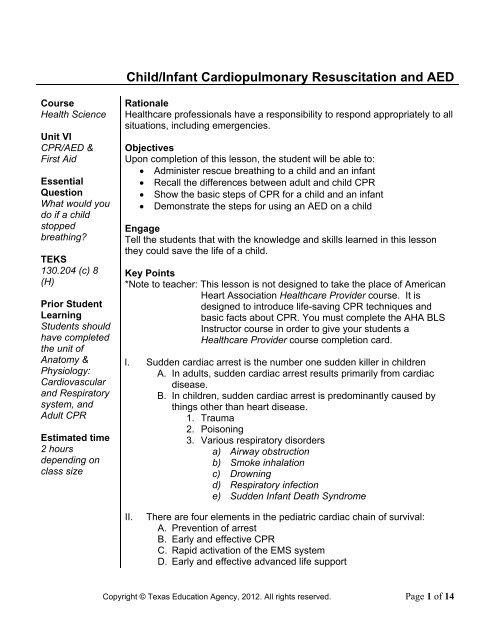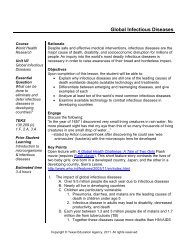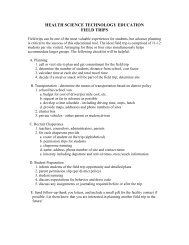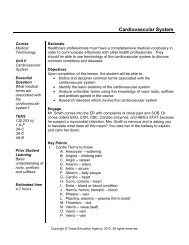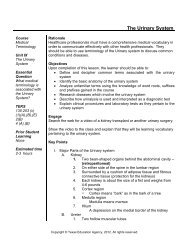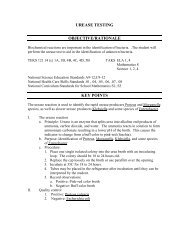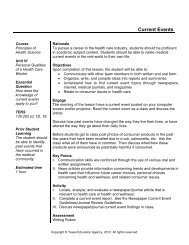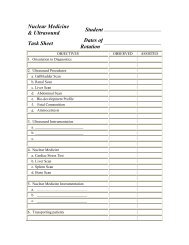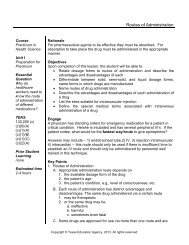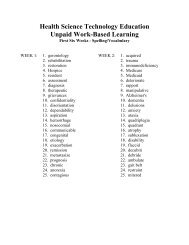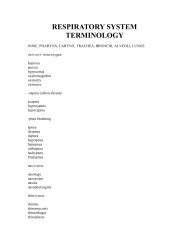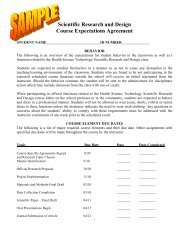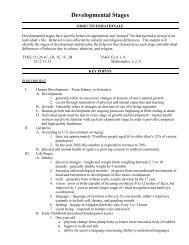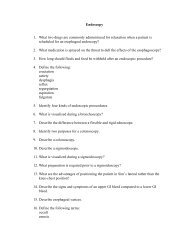Child/Infant Cardiopulmonary Resuscitation and AED - Texas Health ...
Child/Infant Cardiopulmonary Resuscitation and AED - Texas Health ...
Child/Infant Cardiopulmonary Resuscitation and AED - Texas Health ...
You also want an ePaper? Increase the reach of your titles
YUMPU automatically turns print PDFs into web optimized ePapers that Google loves.
III.<strong>Child</strong> CPR should be used on an unresponsive victim between theages of one <strong>and</strong> puberty.A. If you don’t know the victim’s age, look for signs of puberty.B. Signs of puberty include1. Breast development in females2. Underarm, chest, <strong>and</strong> facial hair on malesC. Adult CPR should be done on children that have reached puberty.D. <strong>Infant</strong> CPR is used when the unresponsive victim’s age is birth toone year old.IV. The unconscious victimA. Never attempt CPR on a person that is responsive.B. Establish unresponsiveness1. Shake <strong>and</strong> Shouta) Tap the victim on the shoulder for response.b) Shout, “Hey are you okay?”2. If no responses from the victim, begin the steps of childCPR, <strong>and</strong> have someone call 911 <strong>and</strong> get the <strong>AED</strong> for you.(1) If you are alone, perform 5 cycles of CPR. Ifsomeone has not done so already, thenactivate the emergency response system<strong>and</strong> get an <strong>AED</strong> if available.*** This is different than adult CPR.b) Answer all the 911 dispatcher’s questions.c) Wait until the dispatcher disconnects the phoneconnection before you hang up.3. Anytime you have an unresponsive victim, you should call911, even if you don’t know why the victim is unconscious.4. Be prepared to begin CPR.V. Steps of <strong>Child</strong> CPRA. Make sure the scene is safe.1. Is the victim in a dangerous place?2. Are there any obvious threats or dangers to you or thevictim?B. Make sure the victim is lying on his back on a firm, flat surface.1. If the victim is lying face-down, carefully roll him onto hisback.2. If the victim is face-up on a bed or another soft surface,place a board, or other firm object, under his back.3. A soft surface diminishes the effect of chest compressions.4. Effective chest compressions can only be performed on afirm surface.C. Kneel at the victim’s side <strong>and</strong> open the airway using the head tiltchinlift method.Copyright © <strong>Texas</strong> Education Agency, 2012. All rights reserved. Page 2 of 14
1. Tilt the head by pushing back on the forehead.2. Lift the chin by putting your fingers on the bony part of thechin.3. Do not press the soft tissues on the neck or under the chin.4. Lift the chin to move the jaw forward.D. Check for normal breathing (at least one breath every 3-5seconds).1. Look, Listen <strong>and</strong> Feel.a) Put your ear next to the victim’s mouth <strong>and</strong> nose.b) Look to see if the chest rises.c) Listen for breaths.d) Feel for breaths on your cheek.2. If the victim is breathing normallya) Roll the victim onto his or her side.b) Wait for trained help to take over.c) If the victim stops breathing, start the steps of CPRfrom the beginning.E. If there is no normal breathing, give 2 breaths.1. Hold the airway open with a head tilt-chin lift.2. Pinch the nose closed.3. Take a normal breath <strong>and</strong> cover the victim’s mouth withyour mouth, creating an airtight seal.4. Give 2 breaths, about 1 second each.a) <strong>Child</strong>ren’s lungs are smaller than adult lungs.b) You will not need to blow as forcefully as you dowhen giving adult CPR.5. Watch for chest to rise as you give each breath.6. If the first breath does not go in, re-open the airway with ahead tilt-chin lift <strong>and</strong> try again.7. Room air is 21% oxygen (O 2 ).a) We only use part of the 21% O 2 we breathe in.b) We breathe out waste products <strong>and</strong> “leftover O 2. ”c) It is enough O 2 to be of help to the non-breathingvictim.8. *Note to instructor: Foreign body airway obstruction will betaught in a separate lesson.F. Check for pulse1. <strong>Health</strong>care providers are trained to check for a pulse whilelay persons are not.2. Check the carotid pulse.a) If heart activity is producing any pulse activity at all,there is a better chance of palpating the pulse if youcheck a central pulse.(1) The carotid pulse is close to the heart(2) Peripheral pulses such as the brachial <strong>and</strong>radial pulses are further away from the heartCopyright © <strong>Texas</strong> Education Agency, 2012. All rights reserved. Page 3 of 14
) Locate the trachea using 2 or 3 fingers.(1) Slide these 2 or 3 fingers into the groovebetween the trachea <strong>and</strong> the muscles at theside of the neck(2) Feel for the throb of the carotid pulse for atleast 5, but no more than 10, seconds(3) If you can feel a pulse, <strong>and</strong> the pulse is atleast 60 beats per minute, continue withrescue breathing(a) 1 breath every 5 seconds for adults(b) 1 breath every 3 seconds for a childor baby(4) If you do not feel a pulse OR the pulse isless than 60 beats per minute, AND thereare signs of poor perfusion, begin chestcompressions(a) Poor perfusion is poor circulation(b) Pale or cyanotic skin are signs ofpoor perfusionG. Remove clothes from the front of the chest.1. Clothing is removed so that you can see the l<strong>and</strong>mark forplacing your h<strong>and</strong>s in the correct position.2. Clothing gets in the way when using the automatedexternal defibrillator (<strong>AED</strong>).H. Give 30 chest compressions.1. Put the heel of one h<strong>and</strong> on the center of the victim’schest.a) The center of the chest is between the nipples.b) This puts your h<strong>and</strong> on the lower part of thesternum, but away from the xiphoid process.c) A child’s body is smaller than an adult’s, so oneh<strong>and</strong> will be strong enough to give effective chestcompressions.2. Push hard <strong>and</strong> fast.a) Push straight down on the chest, ⅓ to ½ depth ofthe chest with each chest compression.*** This is different than adult CPR.b) Push at a rate of 100 compressions per minute.3. After each compression, release pressure on the chest tolet it come back to its normal position (recoil).4. A chest compression is an artificial heart beat.a) Compressions pump blood to the brain <strong>and</strong> heart.b) When the heart stops beating, the sooner you startcompressions, the better.(1) Blood is still oxygen-rich at the time theheart stops.Copyright © <strong>Texas</strong> Education Agency, 2012. All rights reserved. Page 4 of 14
c) If the <strong>AED</strong> does not have child pads, adult padsmay be used on a child.*** May use adult pads on a child.*** May NOT use child pads on an adult.2. Open the <strong>AED</strong> pad package <strong>and</strong> peel away the plasticbacking.3. Attach the sticky side of the pads directly to the victim’sbare chest.4. The picture on the pad will show you where to put thepads.C. Clear the victim1. Make sure no one is touching the victim – not even you.2. The victim’s body must be motionless for the <strong>AED</strong> toanalyze the heart rhythm or give a shock.D. Allow the <strong>AED</strong> to check the heart rhythm.1. Many <strong>AED</strong>s audibly say, “Analyzing Now.”2. The <strong>AED</strong> will say, “Shock Advised” or “No shock needed.”3. If “Shock Advised” is said, then you will hear the <strong>AED</strong>charging.E. Push the SHOCK button if the <strong>AED</strong> tells you to do so.F. The <strong>AED</strong> may tell you to resume CPR.1. Do not recheck for a pulse.2. Immediately start chest compressions.VIII. Special Situations when using the <strong>AED</strong>A. Water1. DO NOT deliver shock if victim isa) Lying in waterb) Covered with water(1) Victim is covered with sweat(2) Victim has just been pulled from a pool ofwater(3) If the victim is lying in a small puddle ofwater or snow, but the chest is not coveredwith water, you can give shocks2. Move the victim away from st<strong>and</strong>ing water.3. Quickly wipe the victim’s chest before you attach the pads.4. Water may cause the shock to flow over the skin from onepad to the other: energy won’t get to the heart.B. Medicine patch1. Do not put an <strong>AED</strong> pad over a medicine patch.a) The patch may block some of the shock dose.b) The patch may burn the victim if the pad is placedover a medicine patch.c) Wear gloves when you remove a medicine patch.2. Wipe the chest where the patch was, before you put on theCopyright © <strong>Texas</strong> Education Agency, 2012. All rights reserved. Page 6 of 14
padC. Pacemaker or Internal Defibrillator1. Look for a lump under the skin of the chest that lookssmaller than a deck of cards.2. If you see this lump where the pads should go, put thepads at least 1 inch away from the lump.3. You may use the <strong>AED</strong> on victims with pacemakers orinternal defibrillators as long as you keep the <strong>AED</strong> patch 1inch away from the devices.D. Hairy chest1. If the pads stick to the hair instead of the skin, press downfirmly on each pad.2. If the <strong>AED</strong> still tells you to check the pads, quickly pull offthe pads to remove the hair.3. If a lot of hair still remains where you will put the pads,shave the area with the razor located in the <strong>AED</strong> carryingcase.4. Put on a new set of pads then follow the <strong>AED</strong>’s visual <strong>and</strong>audible prompts.IX. 2-rescuer <strong>Child</strong> CPRA. Performing CPR can be a shared process.B. One rescuer performs chest compressions.1. Give 15 chest compressions.2. Pause after the 15 th compression to give time for thesecond rescuer to give 2 breaths.3. Note that with 2-rescuer child CPR, the ratio betweencompressions <strong>and</strong> breaths changes to 15:2.C. One rescuer gives rescue breaths.1. Give two 1-second breaths.a) Mouth-to-mouthb) Mouth-to-maskc) Bag maskX. Recovery PositionA. Side-lying positionB. Not recommended for infants <strong>and</strong> small childrenC. The side-lying position may block the airway if the head is notadequately supported.*Note to teacher: demonstrate each step of child CPR <strong>and</strong> use of an <strong>AED</strong>.You may choose to demonstrate each step of CPR/<strong>AED</strong> asyou explain the various parts, <strong>and</strong> then show the completesequence at the last part of the lesson.XI. <strong>Infant</strong> CPRCopyright © <strong>Texas</strong> Education Agency, 2012. All rights reserved. Page 7 of 14
A. Age from birth to one yearB. Breaths are smaller than for a child or an adult.C. Chest compressions are done with less force than those usedwith a child or an adult.D. Just as with CPR for a child, if you are alone when you find thechild unresponsive, do 5 cycles of CPR before stopping to call911.XII. The Steps of <strong>Infant</strong> CPRA. Check for responsiveness.1. Don’t shake the baby.2. Tap on the infant’s foot.3. In a loud voice say, “Are you okay?”B. Have someone activate the emergency response system whileyou continue to work on the infant.1. Yell for someone to call 911.2. If you are alone, continue with the steps of CPR, delivering5 cycles of 30:2 before you stop to activate the EMSsystem.C. Open the airway.1. Use the head tilt-chin lift.2. Be careful not to hyperextend the baby’s neck.3. Tilt the head back to only the neutral (sniffing) position.D. Check for breathing.1. Look for the chest to rise <strong>and</strong> fall.2. Listen for air escaping during exhalation.3. Feel for the flow of air against your cheek.E. Give 2 breaths.1. A baby’s nose is very close to his or her mouth.2. Put your mouth over the baby’s nose AND mouth.3. Blow in enough air the make the chest rise.a) A baby’s chest is very small.b) It will only take a puff of air.4. If the first breath does not go in <strong>and</strong> make the chest rise,reposition the airway <strong>and</strong> attempt a second breath.5. You may need to make multiple attempts to get the air in.a) Reposition the head <strong>and</strong> try again.b) Check that you have a good seal if using a pocketmask or bag mask.F. Check the Brachial pulse1. A baby’s neck is short <strong>and</strong> fat.2. It is difficult to get your fingers on the neck to check thecarotid pulse.3. Use 2 fingers to locate the brachial pulse.4. Feel for the pulse for at least 5, but no more than 10,seconds.Copyright © <strong>Texas</strong> Education Agency, 2012. All rights reserved. Page 8 of 14
5. If no pulse is felt, begin infant-CPR.G. Locate the CPR h<strong>and</strong> (finger) position.1. Place your ring <strong>and</strong> middle fingers just below theintermammary line.2. Slightly below the nipple line, in the center of the chestH. Deliver 30 compressions.1. Push straight down on the chest, ⅓ to ½ the depth ofchest, with each chest compression.2. Push at a rate of 100 compressions a minute.3. After each compression, release pressure on the chest tolet it come back to its normal position (recoil).4. The infant needs to be on a firm, flat surface for chestcompressions to be effective.I. Give 2 breaths.1. Just enough air to make the chest rise2. Continue CPR till trained help arrives.XIII. 2-rescuer <strong>Infant</strong> CPRA. The first rescuer delivers 15 compressions.1. When 2-rescuer infant CPR is donea) There is not enough room for both rescuers to beside-by-side while working with the infantb) The rescuer positions the baby so that the baby’sfeet are pointed towards the rescuer2. The rescuer uses the 2 thumb-encircling h<strong>and</strong>s technique,instead of the-2 finger method of compressions.a) Place both thumbs side by side in the center of theinfant’s chest on the breastbone, just below thenipple line.b) Do not press on the xiphoid.c) The thumbs may overlap in very small infants.d) Encircle the infant’s chest <strong>and</strong> support the baby’sback with the fingers of both h<strong>and</strong>s.e) Use your thumbs to depress the breastbone,approximately ⅓ to ½ the depth of baby’s chest.f) Give 15 compressions, smoothly, at a rate of 100beats per minute.g) Pause briefly for the second rescuer to give 2breaths.B. The second rescuer gives 2 breaths.1. Positions him or herself at the head of the baby2. Be ready to give 2 breaths during the pause after the 15 thcompression.C. Continue CPR, with a ratio of 15 compressions to 2 breaths, untiltrained help arrivesCopyright © <strong>Texas</strong> Education Agency, 2012. All rights reserved. Page 9 of 14
XIV. The use of an <strong>AED</strong> is not recommended for infants.ActivityI. Students will practice the steps of <strong>Child</strong> CPR/<strong>AED</strong> <strong>and</strong> <strong>Infant</strong> CPR on apractice manikin.AssessmentStudents will perform the steps of <strong>Child</strong> <strong>and</strong> <strong>Infant</strong> CPR <strong>and</strong> use of <strong>AED</strong> onthe child manikin.RubricMaterialsOne child <strong>and</strong> infant CPR manikin for every 3 studentsManikin cleaning suppliesManikin mouth shieldsCPR Face MaskBag mask (ambu bag)<strong>AED</strong> trainer* If you don’t have CPR manikins, you should check with the athleticdepartment at your school. Sometimes they have CPR manikins.Accommodations for Learning DifferencesFor reinforcement the student will receive one-on-one coaching during CPRpractice.For enrichment, the student may research statistics on child <strong>and</strong> infantmortality rates related to sudden cardiac arrest. The students will share theirfindings with the class.National <strong>and</strong> State Education St<strong>and</strong>ardsNational <strong>Health</strong>care Foundation St<strong>and</strong>ards <strong>and</strong> Accountability Criteria:Foundation St<strong>and</strong>ard 22.11 interpret verbal <strong>and</strong> nonverbal communication2.14 Recognize the elements of communication using a sender-receivermodel.2.15 Apply speaking <strong>and</strong> active listening skills.2.22 Use medical abbreviations to communicate information.Foundation St<strong>and</strong>ard 10: Technical Skills<strong>Health</strong>care professionals will apply technical skills required for all careerspecialties. They will demonstrate skills <strong>and</strong> knowledge as appropriate.Accountability Criteria10.1 Technical Skills10.12 Apply skills to obtain training or certification in cardiopulmonaryCopyright © <strong>Texas</strong> Education Agency, 2012. All rights reserved. Page 10 of 14
esuscitation (CPR), automated external defibrillator (<strong>AED</strong>), foreign bodyairway obstruction (FBAO) <strong>and</strong> first aid. Additional technical skills may beincluded in a program of study based on career specialties.TEKS130.204 (c)(8)(H) demonstrate first aid, vital signs, cardiopulmonaryresuscitation, <strong>and</strong> automated external defibrillator skills in a laboratorysetting.<strong>Texas</strong> College <strong>and</strong> Career Readiness St<strong>and</strong>ardsScience St<strong>and</strong>ard,I. Nature of Science C. Collaborative <strong>and</strong> safe working practicesDemonstrate skill in the safe use of a wide variety of apparatuses,equipment, techniques, <strong>and</strong> procedures.Cross-Disciplinary St<strong>and</strong>ards,I. Key Cognitive Skills D. Academic Behavior: 1. Self monitor learning needs<strong>and</strong> seek assistance when needed, 3. Strive for accuracy <strong>and</strong> precision, 4.Persevere to complete <strong>and</strong> master task. E. Work habits: 1. Workindependently, 2. Work collaborativelyII. Foundation Skills A. 2. Use a variety of strategies to underst<strong>and</strong> themeaning of new words. 4. Identify the key information <strong>and</strong> supportingdetails.Copyright © <strong>Texas</strong> Education Agency, 2012. All rights reserved. Page 11 of 14
<strong>Health</strong> Science<strong>Health</strong> Professional One <strong>and</strong> Two-rescuer<strong>Child</strong> CPR/<strong>AED</strong> ChecklistSteps Action SuccessfullycompletedStep 1 Check for response:Tap the victim <strong>and</strong> ask loudly “Hey areyou okay?” completed skippedStep 2Step 3Step 4Step 5Step 6Tell someone to call 911 <strong>and</strong> get the<strong>AED</strong>Open the airway with the head tilt-chinliftLook, listen <strong>and</strong> feel for breathsGive 2 1-second breaths (keeping theairway open).Bare the victim’s chest <strong>and</strong> place oneh<strong>and</strong> in the proper position to begin CPRStep 7 Give 30 compressions at the rate of 100beats per minute <strong>and</strong> about ⅓ to ½ thedepth of the victim chest. *** Using onlyone h<strong>and</strong>Step 8Step 9Step 10Step 11Step 12Step 13Give 2 1-second breaths completed skipped completed skipped completed skipped completed skipped completed skipped completed skipped completed skippedRescuer two arrives with the <strong>AED</strong>Rescuer one (R1) continues CPR asrescuer two (R2) sets up the <strong>AED</strong> for useR2 turns on the <strong>AED</strong>R2 selects <strong>and</strong> applies the proper childpads correctly (R1 continues with CPRsteps)R2: Clear the victim to analyze.R1: Stops CPRIf shock is advised, R2 clears the victimfor shock <strong>and</strong> presses the shock button. completed skipped completed skipped completed skipped completed skipped completed skippedCopyright © <strong>Texas</strong> Education Agency, 2012. All rights reserved. Page 12 of 14
Step 14Step 15Step 16R2: Resumes CPR, starting with chestcompressions, if the <strong>AED</strong> instructs youto continue CPR. 100 beats per minute,15:2 ratio, pauses after the 15 thcompression to allow R1 to give 2breaths(NO pausing to recheck for pulse)R1: Gives 2 1-second breaths (keepingthe airway open).R2: Gives 15 compressions at the rate of100 beats per minute. Continue CPRuntil the <strong>AED</strong> is ready to reanalyze thevictim, the victim is revived oremergency medical personnel arrive totake over. completed skipped completed skipped completed skipped16 steps completed = 10015 steps completed = 9214 steps completed = 8713 steps completed = 70 <strong>and</strong> needs remediationComments:____________________________________________________________________________________________________________________________________________________________________________________________________________________________________________________________________________________________________________________________________________________Copyright © <strong>Texas</strong> Education Agency, 2012. All rights reserved. Page 13 of 14
<strong>Health</strong> Science<strong>Health</strong> Professional One <strong>and</strong> Two-rescuer<strong>Infant</strong> CPR ChecklistSteps Action Successfully completedStep 1 Check for response:Tap the infant on the feet <strong>and</strong> say loudly“Baby, baby you okay?” completed skippedStep 2 completedTell someone to call 911 skippedStep 3 Open the airway with the head tilt-chinlift completed skippedStep 4 Look, listen <strong>and</strong> feel for breaths (at least5 seconds) completed skippedStep 5 Give 2 1-second breaths (keeping theairway open). completed skippedStep 6 Bare the victim’s chest <strong>and</strong> place the ring<strong>and</strong> middle fingers in the proper positionto begin CPR completed skippedStep 7 Give 30 compressions at the rate of 100beats per minute <strong>and</strong> about ⅓ to ½ thedepth of the victim chest. *** Using onlythe two weakest fingers, i.e. middle <strong>and</strong>ring fingersStep 8Step 9Step 10Step 11 completed skippedGive 2 breaths, just enough to make the completedchest rise skippedRescuer two arrives, after calling 911 <strong>and</strong> is ready to help.**<strong>AED</strong> not recommended for use on an infant.R2: Takes over chest compressions,using the two thumb circling h<strong>and</strong>- completedtechnique, 100 beats per minute <strong>and</strong> a skipped15:2 ratio. Pauses after the 15 thcompression to allow R1 time to give 2breathsR1: Gives 2 breaths (keeping the airwayopen).R2: Gives 15 compressions at the rate of100 beats per minute. Continue CPRuntil the victim is revived or emergencymedical personnel arrive to take over.11 steps completed = 10010 steps completed = 929 steps completed = 878 steps completed = 70 <strong>and</strong> needs remediation completed skipped completed skippedCopyright © <strong>Texas</strong> Education Agency, 2012. All rights reserved. Page 14 of 14


